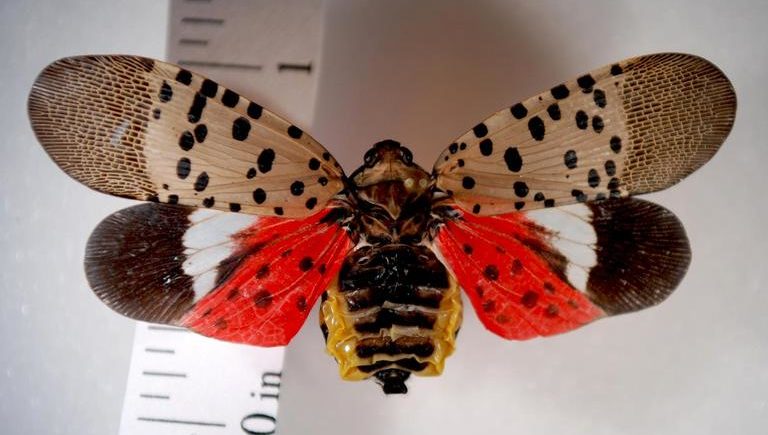A small population of the invasive spotted lanternfly has been found in the City of Fitchburg, according to reports from the Massachusetts Department of Agricultural Resources. Agricultural inspectors are in the middle of performing extensive surveys in the area, but currently the infestation is limited to a single cluster of three trees.
Spotted lanternfly (Lycorma delicatula, “SLF”) is an invasive sap-feeding insect from Asia that was first found in the United States in 2014 in Pennsylvania. While the main host plant of this pest is tree-of-heaven (Ailanthus altissima), spotted lanternfly attacks many different trees, shrubs, and vines, and has the potential to impact a broad range of agricultural commodities, including apples, peaches, grapes/wine, hops/beer, maple syrup, and ornamental plants. While individual spotted lanternflies have been found in several different parts of the state over the past several years, this is the first evidence that Massachusetts has a breeding population.
MDAR is urging the public to be on the lookout for the pest, especially residents that live or work in the Fitchburg area. Spotted lanternflies may be found on sides of buildings, in or on vehicles, and on their preferred host plants: tree of heaven, grape vines, and maple and walnut trees. Anyone who has recently received goods or materials from states where SLF is known to have been introduced (including Connecticut, Delaware, Indiana, Maryland, New Jersey, New York, Ohio, Pennsylvania, Virginia, and West Virginia) should also be on the lookout.
If residents find anything suspicious, they are asked to take a photo or collect the specimen, and report the sighting using MDAR’s online reporting form. Residents should look for both adult insects (large, gray bugs, about one inch long, with black spots and red underwings) and egg masses (inch-long, rectangular masses, yellowish-brown, and covered with a gray waxy coating). The egg masses may be found on any flat surface.
